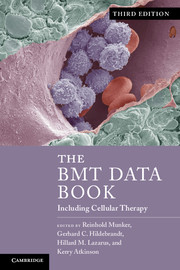Book contents
- Frontmatter
- Contents
- List of contributors
- Foreword
- Preface
- Acknowledgments
- Section 1 Basic science
- Section 2 Hematologic malignancies
- Section 3 Solid tumors
- Section 4 Nonmalignant disorders
- 15 Therapeutic decision making in BMT/SCT for severe aplastic anemia
- 16 Therapeutic decision making in BMT/SCT for congenital immunodeficiencies
- 17 Therapeutic decision making in BMT/SCT for hemoglobinopathies
- 18 HSCT for inborn errors of metabolism and neurodegenerative disorders
- 19 Therapeutic decision making in BMT/SCT for autoimmune disorders
- Section 5 Cellular therapy
- Section 6 Practical aspects and procedures
- Section 7 Complications
- Section 8 The BMT/SCT pharmacopoeia
- Section 9 HLA-testing and laboratory medicine
- Appendix Guide to the internet and literature databases relevant for BMT/SCT
- Index
- References
16 - Therapeutic decision making in BMT/SCT for congenital immunodeficiencies
Published online by Cambridge University Press: 05 August 2013
- Frontmatter
- Contents
- List of contributors
- Foreword
- Preface
- Acknowledgments
- Section 1 Basic science
- Section 2 Hematologic malignancies
- Section 3 Solid tumors
- Section 4 Nonmalignant disorders
- 15 Therapeutic decision making in BMT/SCT for severe aplastic anemia
- 16 Therapeutic decision making in BMT/SCT for congenital immunodeficiencies
- 17 Therapeutic decision making in BMT/SCT for hemoglobinopathies
- 18 HSCT for inborn errors of metabolism and neurodegenerative disorders
- 19 Therapeutic decision making in BMT/SCT for autoimmune disorders
- Section 5 Cellular therapy
- Section 6 Practical aspects and procedures
- Section 7 Complications
- Section 8 The BMT/SCT pharmacopoeia
- Section 9 HLA-testing and laboratory medicine
- Appendix Guide to the internet and literature databases relevant for BMT/SCT
- Index
- References
Summary
Introduction
Among the early successes of allogeneic BMT were those achieved in the area of congenital immunodeficiencies. In certain diseases and certain donor–recipient combinations, over 90% of patients can be cured by allogeneic transplantation. Worldwide, over 3000 patients with congenital immunodeficiencies have been treated by allogeneic transplantation. The following table gives a list of the current indications. Patients with congenital immunodeficiencies generally manifest as severe infections within the first year of life. In the absence of a hematopoietic SCT or BMT, most severe immunodeficiencies are fatal. The European Society for Immunodeficiencies (ESID) in collaboration with the EBMT provides guidelines for the conditioning regimens in use for primary immunodeficiencies (www.esid.org and www.ebmt.org). For reviews related to BMT and congenital immunodeficiencies, see Buckley, 2003; Buckley et al., 1999; and Steward and Jarisch, 2005. Szabolcs et al. (2010) gave a very detailed overview of the primary immunodeficiencies treated by BMT/SCT.
With the advent of genetic mapping, SCID is now increasingly classified on a genetic basis. This gives a more precise characterization of the immunological defects. Thus, it is becoming clear which types have the best cure rate, allowing the stratification of therapy. For example, patients with a mutation in the antigen receptor gene Artemis (resulting in a T-B- NK+ phenotype) were described as having a worse prognosis.
- Type
- Chapter
- Information
- The BMT Data BookIncluding Cellular Therapy, pp. 172 - 178Publisher: Cambridge University PressPrint publication year: 2013



